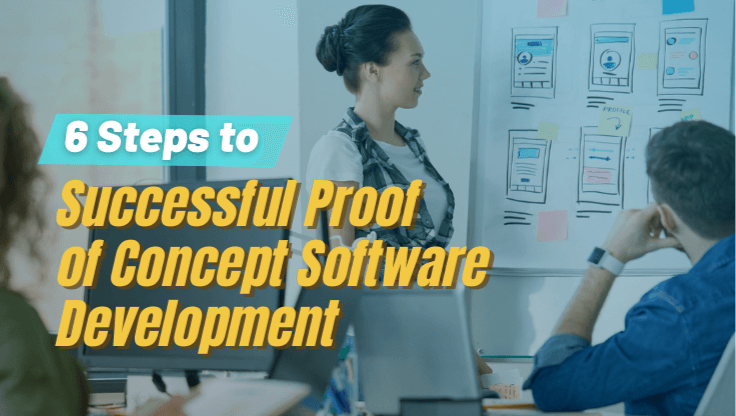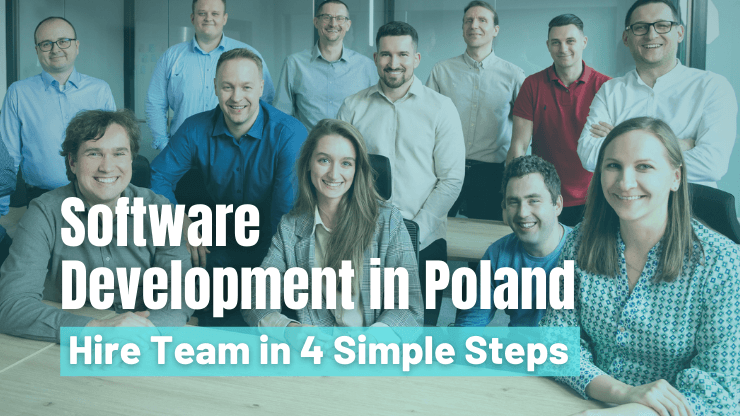Over 66% of software projects fail. Proof of concept (PoC) development can help to reduce this risk of failure significantly.
Testing a software project’s most basic functionality with a PoC can help teams evaluate feasibility and validate market needs before investing significant time and money into a project.
In this article we will walk through 6 steps to quickly develop a proof of concept for your next software project.
What is a proof of concept?
A proof of concept is a demonstration of the feasibility of a particular software development project, business, or product idea. While not a required part of every software development project, this very early stage assessment of feasibility can help to reduce project risk and prevent investment in a project that lacks practicality or market demand.
A PoC can come in many forms, from a landing page or a marketing video to a crowdfunding campaign or ultra-basic physical prototype. The unifying idea is that a proof of concept should be low cost, quick to build, and require minimal software development services.
A PoC is typically developed internally with a small group of people to help keep costs down. However sometimes a custom software development company will be brought in to develop the proof of concept for a new startup that doesn’t have adequate resources internally.
A proof of concept should not be used to:
- Evaluate the technical feasibility of a project (use a prototype instead)
- Develop branding or UI/UX design for the final product (do this in a later design phase)
- Build a shippable or minimally viable product (use an MVP instead)
Why is PoC development important?
A proof of concept is important in software development projects because it gives developers and startup teams a way to test their ideas before committing to a large project.
In short, a software proof of concept can helps teams:
- Test a new business model or strategy
- Validate a software idea is worth pursuing further
- Gauge demand within the target market
- Determine interest in a new or original idea
- Get feedback from intended users and/or the target audience
PoC vs prototype vs MVP
There are a lot of terms thrown around when it comes to product development, and it can be confusing to keep track of all of them. A proof of concept (PoC), prototype, and MVP are all distinctly different phases of the product development lifecycle.

A proof of concept (PoC) is built very early in the product life cycle, potentially before any investment is raised, a full team is formed, or a formal business idea is established. It is used to prove if a project is feasible or not. This validation stage is critical as it can help to justify costly design and development work that comes later.
A prototype is typically where your product becomes tangible for the first time. It’s meant to give teams an idea of what they are going to build - a way to visualize things for the first time. The level of detail of a prototype can vary significantly. The lowest budget option would be to sketch out a design with pen and paper. More advanced prototypes can be created in tools such as Figma. When deciding on the type of prototype for your product, consider your budget and timeline. These two elements will dictate how complex your prototype can be.
Finally, a minimum viable product (MVP), is the most basic version of working software that can be released to real users. Typically work done on a prototype will be used to build the MVP. As the MVP is released into the market, the development team can get valuable data on what works and what doesn’t work. This data will be used to create later versions of the product.
6-step proof of concept development process
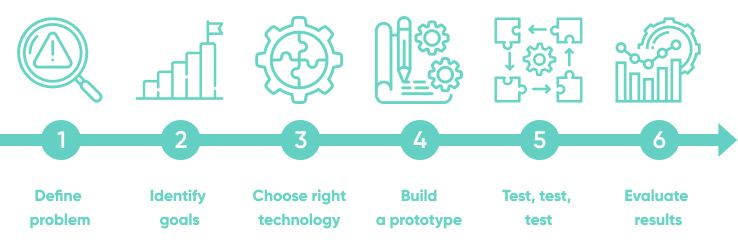
Set goals for the proof of concept
Before you formulate a full plan for PoC development, you should establish your goals. Earlier we discussed these common uses for a PoC:
- Test a new business model or strategy
- Validate a software idea is worth pursuing further
- Gauge demand within the target market
- Determine interest in a new or original idea
- Get feedback from intended users and/or the target audience
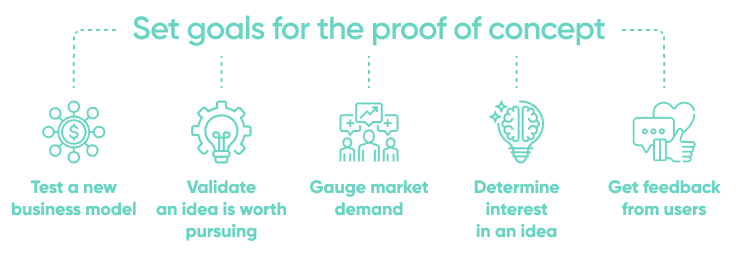
Think through which, if any, of the above possible outcomes would be helpful for your team.
A proof of concept could fulfill just one goal or it could fulfill more than one. It depends on the scope of the project, funding available, and complexity of the proof of concept. Some teams may find that they meet their goals in phases.A PoC could help to validate basic feasibility of the project. A later prototype could help to validate technical risks and generate customer feedback.
Once the goals of the proof of concept project have been identified, the next step is to decide on the general PoC approach you want to take.
Decide on the general PoC approach
A proof of concept can come in many forms. Your goals defined in the first step should inform the approach you decide to take.
If you’re using your PoC to prove feasibility of a brand new type of product or service, you may opt to build something that allows you to demonstrate how it would function on a very basic level. On the other hand, if you are using your PoC to prove the feasibility of implementing a particular technology, you should focus on how to demonstrate that, at least at a basic level, the technology can be used. In that case, the look and feel of the prototype may be less important.
Common PoC approaches include:
| PoC Approach | Best For | Difficulty / Cost |
|---|---|---|
| Blog Post - Explain your product idea in the form of a blog. | Teams with really low budgets who simply want to gauge interest and gather feedback from the intended audience. | Low |
| Landing Page - Showcase your product with a modern website landing page. | Teams with a little design or marketing know-how who can spin up a well-designed web page but prefer not to build any kind of physical product. | Low |
| Explainer Video - Use a video to explain the final product you intend to build. | Teams that do not want to do any software development, but still want to visually show how the intended solution would function. | Medium |
| Customer Interviews - Get input from real people. | Teams who primarily want to focus on validating their product would be of interest to potential users. | Medium |
| Crowdfunding - Use a platform like Kickstarter to raise funding and validate your project idea at the same time. | Teams who need a low to modest amount of funding and who are able to put together a well-thought through marketing package to tell a compelling story. | Medium |
| Simple Prototype - Develop an ultra-basic, design-free version of your product. | Teams who have some software development know-how and want to test out their idea by building a super primitive version of the product. | High |
Before you decide how to move forward, check out real proof of concept examples to get inspiration and see how various proof of concept approaches worked for different startups.
Choose the right technologies or platforms
Choosing the right technology for your software proof of concept is critical to its success. There are a few key things to keep in mind when making this decision.
First, you need to consider the purpose of your proof of concept. Think through what you identified in steps 1 and 2. What are your goals? Which general approach do you want to take? Once you know this, you can start to narrow down your options.
Next, you need to think about your audience. Who will be using your proof of concept? Will people be physically interacting with it in some capacity or will they be watching a video or reading about it? What are their needs and expectations? This will help you further narrow down your technology options.
Finally, you need to consider your budget. What can you afford to spend on your proof of concept? Will you build a more advanced proof of concept later? Or will this proof of concept need to meet all of your goals for your project? This will help you finalize your decision on the right technology to use.
You should aim to keep your proof of concept as simple and low cost as possible. Unlike a full prototype or MVP, you don’t need to reuse software from your proof of concept. So, when in doubt, go with the simplest technology stack that will allow you to build quickly.
Select the development team
Working with a smaller company will make it more likely that they see you as a partner and create a level playing field. A culture fit in this sense will encourage teamwork and a shared vision, the benefits of which can be limitless. Consider the vendor to be part of your team and you should see that they feel the same back if they are worth their salt.
This will also allow them to better understand your business needs, provide post-dev support service, and enhancements to the product. They’ll be more accountable when things are wrapped up if you need any support later down the line.
All the way through the stages we have listed so far, you should be able to tell that your future partner is trying their best (and succeeding) to understand your needs. If they can’t, things are going to take a lot longer, become more expensive and the overall quality of the product is going to suffer.
The more questions they ask, the better. Pay attention if your partner wants to make sure that they’re on the same page as you on the business requirements.
Build the proof of concept
At this point you’ve mapped out your project goals and selected the technologies you will use to build your proof of concept. You should have a clear idea of what the prototype should look like, what general approach you’re going to take, what it should include, and what it should not include.
Now it’s time to actually get to building it!
Because it is used to justify further development, your proof of concept prototype will likely be built very early in the lifecycle of your new product. You may or may not have a full-fledged business plan. Use what you have. Focus on the information you do have about the direction you intend to take your product. Don’t worry too much about not having everything fleshed out - that’s what a proof of concept can help you do, afterall!
Keep your proof of concept as simple and bare bones as possible. To help keep costs down and reduce the time required to build it, you should:
- Keep the PoC development team small. Minimizing the number of people working on the PoC will help to keep the work more efficient.
- Minimize the amount of UI/UX design work. This type of work can be costly. Only do work that is strictly necessary to meet the goals you established for your PoC.
- Focus only on the goals you established for your PoC. Do not attempt to build an MVP. That should be a separate stage of development.
After you have your proof of concept built, you’ll be ready to start assessing the results!
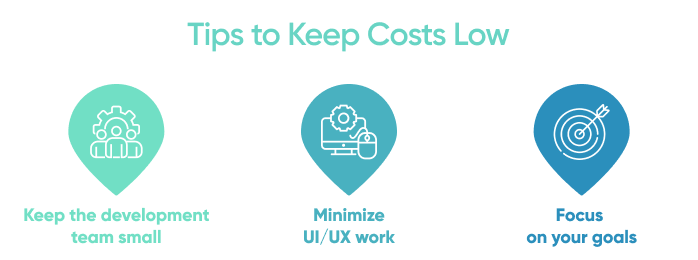
Assess feasibility of the software product
Arguably the most important step in proof of concept development is evaluating your results. This is where you determine if the proof of concept has successfully validated feasibility of the project at hand or not.
So did your proof of concept pass the test? Did you get a green light to keep going? Or did it help you see why you shouldn’t invest any more time into the project? These are the questions you should focus on at this stage.
Depending on the scope of your PoC, at this stage you can validate:
- The ability of the software project to achieve the desired business outcomes. This includes assessing the impact of the project on the business, and determining whether the project will meet the business objectives.
- The costs associated with the software project. This includes assessing the financial feasibility of the project, and determining whether the project is affordable.
- The timeline for the software project. This includes assessing the project schedule, and determining whether the project can be delivered on time.
- The resources required for the software project. This includes assessing the human resources, equipment, and other resources required for the project.
- The risks associated with the software project. This includes assessing the risks associated with the project, and determining how these risks
If you’re ready to move forward with your project, start investigating what it would take to begin the software development process.
If you’ve decided to abandon your project, don’t despair. You should be glad that you didn’t sink too much time or money into a project that wasn’t feasible.
Conclusion
At its core, a proof of concept can help to determine if a software project is feasible or not. While it will require a small initial investment, a successful PoC can help teams prevent a significant amount of project risk later.
A PoC that provides real business value should allow the development team to evaluate a project’s general feasibility, estimate budgets more accurately, validate market needs, and clarify performance limitations of the proposed software project. Following the 6-step process we have outlined in this article will help any business to develop a PoC that successfully delivers on these goals.
If you're looking for help developing a PoC, consider our software development agency. Our team can work with you to put together a comprehensive plan and guide you through the development process - reach out for a free quote.

